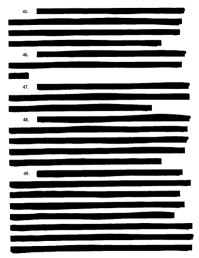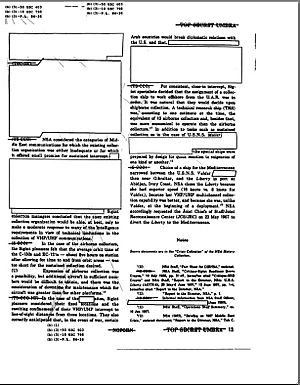Redaction facts for kids
Redaction is like hiding secret information in a document so that it can be shared with more people. It's done to make sure only certain information is seen, while sensitive or private parts are kept hidden. Imagine you have a diary, and you want to share a story from it with a friend, but you don't want them to know about a secret part. You'd "redact" or cover up that secret part before showing it to them!
This process is also called sanitization. It's used for many reasons. Sometimes, it's to protect secrets, like in government documents. Other times, it's to protect people's privacy, like hiding personal details in a report. Redaction was first used for paper documents, but now it's very important for computer files too.
Contents
What is Redaction?
Redaction is the process of removing sensitive or secret information from a document. This makes the document safe to share with a wider audience. It's all about letting some information be seen, but not all of it. The goal is to create a version of the document that can be published or given to people who weren't meant to see the original, full version.
When governments use redaction, it's often to protect national secrets. They might remove highly classified parts to make a document less secret, or even completely unclassified. When it's about protecting people's personal information, it's often called data anonymization. This means making sure no one can figure out who the information belongs to.
Hiding Secrets in Government Documents
Governments often have documents with very important and secret information. Before these documents can be shared with the public, or even with other parts of the government, they need to be checked carefully. Redaction is used to remove any sensitive or classified details. This usually happens when documents are being declassified, meaning they are no longer considered top secret.
How Paper Documents Are Redacted
When redacting paper documents, people used to simply cover parts of the text. They might use a wide black pen to draw over the words. Or they would use special opaque tape to cover the sections. After covering the text, they would make photocopies. This way, the hidden text wouldn't show up on the copies.
However, this simple method has some small risks. If the pen or tape isn't wide enough, you might still be able to see tiny bits of the hidden text. Also, you can still tell how long the hidden words were. This might help someone guess what was hidden. For example, if a short word was hidden, it's easier to guess than a long sentence.
Redacting Digital Files: A Bigger Challenge
Redacting computer files is much harder than redacting paper documents. When you edit a document on a computer, like in a word processor, the program often saves a history of all the changes you made. This means the original, unredacted text might still be hidden in the file's history!
Also, some file types, like PDFs, can be tricky. If you just draw a black box over text in a PDF, the original text might still be underneath that box. Someone could simply delete the black box and see all the hidden information!
To properly redact electronic documents, you need to completely remove all the hidden text and images from the file. This is a complex process that special software can help with. These tools make sure the sensitive data is truly gone.
Sometimes, when government documents are released, the redacted areas are marked. These marks explain why that specific information was hidden. For example, documents released under the Freedom of Information Act in the US often have codes that tell you the reason for the redaction.
There have been cases where digital redaction went wrong. For example, in 2005, a report about an event in Iraq was released as a PDF. People soon found out that they could copy and paste the "hidden" text from the PDF into another program and read it! This happened because the sensitive parts were only covered by black boxes, not truly removed.
These kinds of mistakes show why it's so important to use the right tools and methods for redaction. If not done correctly, sensitive information can accidentally be shared. The two most common mistakes are:
- Adding a black image or shape over the text without actually deleting the text underneath.
- Changing the text color to match the background color, making it invisible but still present.
In both these cases, the hidden information is still in the document. It can be found by searching or even by simply copying and pasting. Proper redaction tools make sure the sensitive information is permanently removed. This often involves several steps, where different people check and approve the redactions before the final document is created.
See also
 In Spanish: Expurgación para niños
In Spanish: Expurgación para niños
- Censorship
- Data erasure
- Data remanence
- Lacuna



